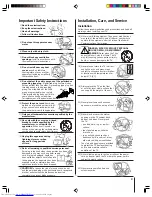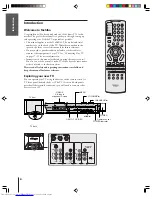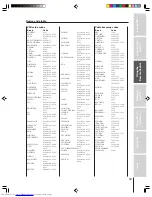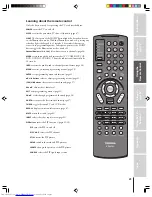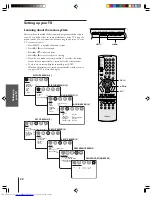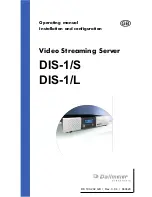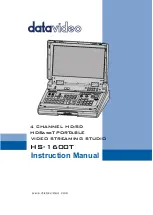
Intr
oduction
Connecting
y
our T
V
Using the
Remote Contr
ol
Setting up
y
our T
V
Using the T
V’s
F
eatur
es
Appendix
Index
9
Note:
•
For the highest possible picture quality
from a DVD player/satellite receiver that
does not have component video
connections, use an S-video cable (plus the
standard audio cables) between the TV
and DVD player/satellite receiver.
If your
DVD player (or satellite receiver) has
component video, see “Connecting a
DVD player with component video and a
VCR” on page 10.
•
Do not connect both an S-video cable and
a standard video cable to VIDEO-1 on the
TV back (or VIDEO-3 on the TV front) at
the same time, or the picture performance
will be unacceptable.
•
Do not connect the DVD player/satellite
receiver and VCR to the same VIDEO input
on the TV. (See the illustration at left, which
shows the DVD player/satellite receiver
connected to VIDEO-1 and the VCR
connected to VIDEO-2.)
The unauthorized recording, use, distribution,
or revision of television programs, videotapes,
DVDs, and other materials is prohibited under
the Copyright Laws of the United States and
other countries, and may subject you to civil
and criminal liability.
ANT( 75 )
ANT-1
OUT
ANT- 2
OUT
IN
S-VIDEO
VIDEO
VIDEO 1
VIDEO 2
L /
MONO
AUDIO
R
DVD IN
P
R
P
B
Y
COLOR
STREAM
INPUT
L
AUDIO
R
OUT
ON
OFF
AUDIO CENTER
CHANNEL IN
IN from ANT
VIDEO AUDIO
OUT to TV
CH 3
L
R
CH 4
IN
OUT
IN from ANT
VIDEO
OUT
OUT
S-VIDEO
AUDIO
OUT
L
R
L /
MONO
AUDIO
R
VIDEO
VAR/FIX
L
PIP AUDIO
R
Connecting a DVD player or satellite receiver
and a VCR
This connection allows you to watch DVD/satellite, VCR, and TV
programs. You can record one TV channel while watching another
channel.
You will need:
• two (or three, if satellite receiver is used) coaxial cables
• one set of standard A/V cables
• one S-video cable
• one pair of standard audio cables
Stereo VCR
From Satellite Dish
(for Satellite
Receiver only)
DVD Player/Satellite Receiver with S-video
TV
From Cable, Cable
Box, or Antenna



